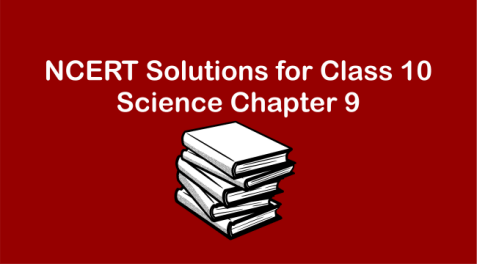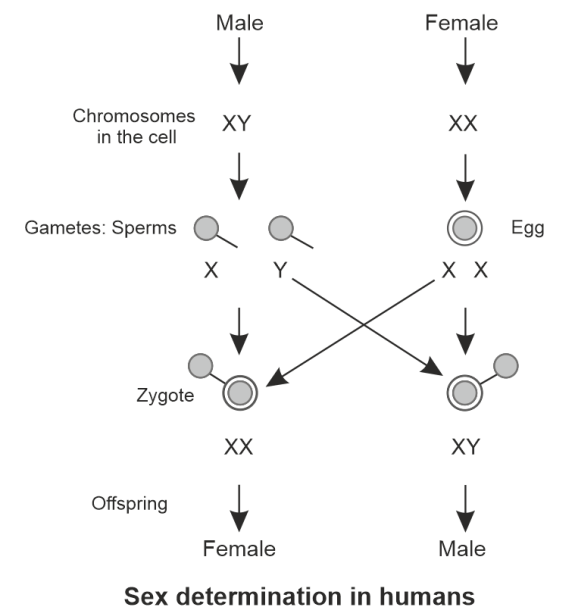NCERT Solutions for Class 10 Science Chapter 9 Heredity and EvolutionThis article has been written for class 10 students searching for solutions to chapter Heredity and Evolution, chapter 9 of Science. All solutions have been provided in detail, along with a proper explanation. Be it inside-chapter questions or the exercise question. Every solution has been written with in-depth knowledge so that it just gets easy for students to understand these solutions without reading the textbook. Reading solutions with proper explanations will help students get a better grasp of the theory part. Solutions are very helpful as it helps in saving time which students can use for self-study. 
NCERT Solutions for Class 10 Science Chapter 9 Inside Chapter QuestionsPage Number: 143Question 1: If a trait A exists in 10% of a population of an asexually reproducing species and a trait B exists in 60% of the same population, which trait is likely to have arisen earlier? Answer: Trait B, because it is present in more members of the population. It is likely to have arisen earlier and has now spread to 60% of the population. Trait A is new and has spread to only 10% of the population. Question 2: How does the creation of variations in a species promote survival? Answer: The variations provide stability to the population of various species by preventing them from getting wiped out during adverse conditions. The natural environment also changes, and variations in species suited to the environment help them survive. Page Number: 147Question 1: How do Mendel's experiments show that traits may be dominant or recessive? Answer: Mendel used pea plants that were tall and dwarf (or short), which had different properties. He obtained all tall plants in the first generation of cross-pollination (F1). However, because F1 tall plants were self-pollinated, the second generation of plants had a 3:1 ratio of tall to short trousers. Based on these studies, the traits that showed up in the first generation were referred to as dominant (for example, tall plants), while the traits that did not show up were referred to as recessive (dwarf, i.e., plants). Question 2: How do Mendel's experiments show that traits are inherited independently? Answer: Mendel performed dihybrid crosses by crossing two pairs of alternative expressions of two characteristics. Dominant qualities are those that originally arose in the first generation. Plants of various sorts were created when he self-pollinated these F1 progeny to produce F2 progeny. Other plants had both dominant qualities, while others had recessive features, and some plants had both traits. This suggests that characteristics are passed down separately. Question 3: A man with blood group A marries a woman with blood group O and their daughter has blood group O. Is this information enough to tell you which of the traits - blood group A or O - is dominant? Why or why not? Answer: This knowledge is insufficient because each person carries two alleles. Only when two individuals have comparable alleles may the recessive characteristic develop. If blood group A is dominant and blood group O is recessive, a daughter can only have blood group O if the mother carries both recessive alleles and the father carries both O and A alleles. Question 4: How is the sex of the child determined in human beings? OR "The sex of a newborn child is a matter of chance and none of the parents may be considered responsible for it." Justify this statement with the help of a flow chart showing determination of sex of a newborn. Answer: The X and Y chromosomes are split equally among the male gametes (sperm). Only the X chromosome is present in every female gamete. The following scenarios are made feasible when a sperm fertilizes an egg: i.) When an egg with just the X chromosome is fertilized by a sperm bearing the X chromosome, the resultant zygote matures into a girl (XX condition). ii.) A male zygote is produced when a sperm with a Y chromosome fertilizes an egg with just an X chromosome (XY condition). Thus, there is a 50/50 probability that a kid will be male or female, and neither of the parents can be held accountable for it. The process for determining sex is shown in the picture below: 
Page Number: 150Question 1: What are the different ways in which individuals with a particular trait may increase in a population? Answer: There are several methods for people with a certain trait to become more prevalent in a group, including: i.) If the benefit of survival through natural selection is provided. ii.) As a result of genetic drift, or the abrupt emergence of a specific characteristic in a population. Question 2: Why are traits acquired during the life-time of an individual not inherited? Answer: The characteristics that an organism acquires over its lifetime are alterations to its non-reproductive cells, which cannot be passed on to the following generation. Question 3: Why are the small numbers of surviving tigers a cause of worry from the point of view of genetics? Answer:From a genetics perspective, the tiny numbers of surviving tigers are concerning since tigers have very few genetic variants. They are not well suited as a result. They cannot benefit from rapid environmental changes. Tigers will go extinct if these alterations are not stopped. Page Number: 151Question 1: What factors would lead to the rise of a new species? Answer: The following are the elements that might cause the emergence of a new species: i.) Geographic isolation is brought on by many forms of impediments for a population (such as mountain ranges, rivers, and seas). There is no gene flow across divided populations due to reproductive isolation brought on by geographic separation. ii.) Genetic drift brought about by abrupt variations in the frequency of certain genes due to pure chance. iii.) Individual variations brought on by natural selection. Question 2: Will geographical isolation be a major factor in the specification of a self- pollinating plant species? Why or why not? Answer: Because self-pollinating plant species do not need to seek other plants to reproduce, geographic isolation cannot be a significant factor in their selection. Question 3: Will geographical isolation be a major factor in the specification of an organism that reproduces asexually? Why or why not? Answer:An asexually reproducing organism does not need another organism to carry out reproduction. Hence geographic isolation cannot be a significant component in its definition. Page Number: 156Question 1: Give an example of characteristics being used to determine how close two species are in evolutionary terms. Answer: Similar traits are regarded as having been passed down from a common ancestor if they appear in diverse creatures. It demonstrates how closely related the species are. For instance, since lizards and squirrels lack wings, they are not closely related to birds and bats despite having certain similarities in their wings, which makes bats and birds. Question 2: Can the wing of a butterfly and the wing of a bat be considered homologous organs? Why or why not? Answer: Although they are employed for the same purpose of flight, the wings of a butterfly and a bat cannot be considered homologous organs since they have distinct fundamental architecture. They are comparable organs. Question 3: What are fossils? What do they tell us about the process of evolution? Answer: The remnants or evidence of a deceased creature are called fossils. These are created as a result of sedimentary rock formation. They offer the following details on the evolutionary process. 1.) They describe the alterations to the organisms and the earth's surface. 2.) They describe how simple, organized creatures evolve into more sophisticated ones over time. 3.) It is known that birds descended from reptiles. 4.) They claim that pteridophytes and gymnosperms give rise to angiosperms.. 5.) They demonstrate the evolution of humanity. Page Number: 158Question 1: Why are human beings who look so different from each other in terms of size, colour and looks said to belong to the same species? Answer: This is true that even while there may be some genetic variation across human races, there is still no reproductive isolation. One species can be distinguished from another by its reproductive isolation. Humans who differ in height, color, and appearance can be married and have fruitful kids. Question 2: In evolutionary terms, can we say which among bacteria, spiders, fish and chimpanzees have a 'better' body design? Why or why not? Answer: Bacteria are considered to be primitive organisms due to their recent evolutionary origin. But even after millions of years, these species can still survive in the current environment. This is a result of their successful environmental adaptation throughout the years. The same is true for all other animals, including spiders, fish, and chimps, who have survived by adapting to their surroundings. All living things have superior body designs because they adapt more to their environments. NCERT Solutions for Class 10 Science Chapter 9 Textbook Chapter End QuestionsQuestion 1: A Mendelian experiment consisted of breeding tall pea plants bearing violet flowers with short pea plants bearing white flowers. The progeny all bore violet flowers, but almost half of them were short. This suggests that the genetic make-up of the tall parent can be depicted as:
Answer: c.) TtWW Question 2: An example of homologous organs is :
Answer: d.) All of the above Question 3: In evolutionary terms, we have more in common with :
Answer: a.) A Chinese school-boy Question 4: A study found that children with light coloured eyes are likely to have parents with light coloured eyes. On this basis, can we say anything about whether the light eye colour trait is dominant or recessive ? Why or why not ? Answer: There are gaps in this data. This makes it impossible to determine whether the characteristic of light colour is dominant or recessive. Therefore, it is impossible to say without first knowing the nature of this feature in the parents. Question 5: How are the areas of study-evolution and classification interlinked? OR 'Two areas of study namely 'evolution' and 'classification' are interlinked". Justify this statement. Answer: The relative similarities and differences between species are used to classify them. Organisms have a common ancestor, explaining why they are similar, and differ from one another owing to environmental adaptations. The fact that organisms can be ranked in ascending complexity points to the theory of evolution. Question 6: Explain the terms analogous and homologous organs with examples. Answer: Analogous: Organs with comparable appearances and similar functions but differing underlying structures (or different basic designs) are referred to as analogous organs. For example, the wings of a bird and an insect are similar organs. Homologous: Homologous organs are those that have the same fundamental structure (or fundamental design) yet serve distinct purposes. Examples of homologous organs are the wing of a bat, the flipper of a seal, the front leg of a horse, and the arm of a man. Question 7: Outline a project which aims to find the dominant coat colour in dogs. Answer: Let's say a white homozygous female mates with a black homozygous male. The predominate coat colour is black if the offspring produces only black dogs. Question 8: Explain the importance of fossils in deciding evolutionary relationships. Answer: Because we can determine an organism's evolution by looking at a fossil's age, fossils serve a crucial role in giving evolutionary evidence. For instance, the ancient bird archaeopteryx exhibited many characteristics of reptiles while having a bird-like appearance. Although its jaws and tail were like those of a reptile, it possessed feathered wings like those of a bird. Because Archaeopteryx serves as a transitional species between reptiles and birds, it is possible that birds descended from reptiles. Because Archaeopteryx serves as a transitional species between reptiles and birds, it is possible that birds descended from reptiles. Question 9: What evidence do we have for the origin of life from inanimate matter? Answer: 
J.B.S. Haldane, a British scientist, first proposed that life began in inanimate matter in 1929. He believed that the basic inorganic substances that were there at the time must have given rise to life. Miller and Urey later presented the findings in 1953. They put up a device to simulate the early earth's atmosphere, which was meant to include gases like methane, ammonia, hydrogen sulphide, and other similar substances over water. Electric sparks were then delivered through the combination of gases to generate lightning for around one week while it was kept at a temperature slightly below 100°C. After one week, it was discovered that 15% of the carbon (from methane) had been transformed into simple chemicals and amino acids, which are the building blocks of protein molecules produced in living things. This experiment offers proof that inorganic molecules, or lifeless matter, were the first source of life. Question 10: Explain how sexual reproduction gives rise to more viable variations than asexual reproduction. How does this affect the evolution of those organisms that reproduce sexually? Answer: Chromosomes "cross over" during sexual reproduction, which results in differences. These changes are hereditary and boost the odds of survival of an organism. 1.) Variations may arise during sexual reproduction as a result of mistakes in DNA copying. 2.) Variations may occur as a result of the exchange of homologous chromosomes when male and female cells cross over. 3.) In sexual reproduction, the gamete that will unite with another gamete is not predetermined. The sole factor is chance. It causes variety as well. The organisms can adapt to the shifting environmental conditions thanks to these variances, which also aid in the emergence of new species. Question 11: How is the equal genetic contribution of male and female parents ensured in the progeny? Answer: Chromosome pairs make up the genetic material of the majority of creatures. Meiosis, a process in which each gamete receives half of its genetic material, produces gametes in sexually reproducing organisms. The normal complement is restored during sexual reproduction when the gametes from the male and female parents unite. The male and female each contribute half of the genetic material. Question 12: Only variations that confer an advantage to an individual organism will survive in a population. Do you agree with this statement? Why or why not? Answer: Yes, advantageous variants are passed down from one organism to the next. The creature can continue to live in a population and last longer in a given environment.
Next TopicClass 10 Science Chapter 10
|
 For Videos Join Our Youtube Channel: Join Now
For Videos Join Our Youtube Channel: Join Now
Feedback
- Send your Feedback to [email protected]
Help Others, Please Share









